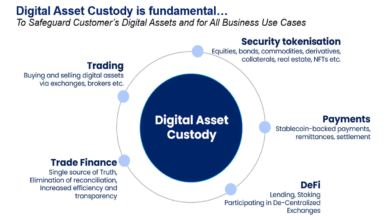Stablecoin Adoption: Lagarde Warns of Money Privatization Risks

The rapid advancement of stablecoin adoption has garnered significant attention and concern from economic leaders, most notably ECB President Christine Lagarde. As these digital currencies grow in popularity, they present a challenge to traditional monetary systems and highlight the potential risks associated with the privatization of money. Lagarde emphasizes that stablecoins, often backed by private entities, could undermine the sovereignty of central banks and their ability to effectively implement monetary policy. Her warnings come as the European Central Bank explores the introduction of the digital euro, which aims to compete in a landscape increasingly dominated by private digital assets. The delicate balance between innovation and regulation has never been more crucial as the financial world navigates the complexities brought about by stablecoin adoption.
The surge in the use of digital currencies, particularly stablecoins, raises critical discussions among financial authorities. These blockchain-based tokens have the capacity to serve as viable alternatives to traditional money, challenging central banking systems and the concept of public finance. Christine Lagarde, a significant voice in this debate, warns about the implications of allowing privately issued currencies to operate in a space meant for public monetary instruments. As policymakers consider the introduction of the digital euro, they face the pressing need to address the risks of this financial privatization while harnessing the benefits of technological advancements in digital payments. The conversation around these innovations is essential to ensure that monetary sovereignty is maintained in an ever-evolving economic landscape.
Understanding Stablecoin Adoption and Its Risks
Christine Lagarde, the President of the European Central Bank (ECB), has raised alarms about the recent surge in stablecoin adoption, highlighting significant risks associated with these digital assets. Stablecoins, often pegged to fiat currencies, are issued by private companies, which introduces a competitive dynamic with traditional central banking. The primary concern for Lagarde is the potential erosion of monetary sovereignty, as the proliferation of stablecoins may weaken the central banks’ ability to implement effective monetary policy. This ushering in of non-state money could lead to a fragmented financial landscape, where private entities dictate terms traditionally reserved for public institutions.
Moreover, Lagarde warns that this growing acceptance of stablecoins complicates the definitions of money and payment mechanisms. She points out that the confusion stemming from these new technologies could mislead the public and policymaking bodies, mistaking stablecoins for legitimate forms of money. By conflating these new digital currencies with traditional money, the risks increase—encouraging further dependence on private entities for monetary functions that have historically been a public domain.
The Impact of Stablecoins on Central Banks and Monetary Policy
As stablecoins continue to gain traction, their implications for central banks become increasingly pronounced. Lagarde emphasized that a widespread embrace of these digital currencies could significantly hinder the efficacy of monetary policy as enforced by central banks. Typically, central banks rely on their capabilities to control money supply and regulate interest rates to stabilize the economy. However, if a substantial portion of the payment ecosystem transitions to stablecoins, it may dilute the influence that central banks have over economic shifts, thereby complicating the implementation of economic strategies.
Additionally, Lagarde stands firm in her belief that stablecoins should not be categorized as legitimate money. This perspective reflects a broader concern within the realm of central banking where the privatization of money could ignite unforeseen economic disparities. Central banks, like the ECB, have the mandate to ensure economic stability and safeguard public interests. If private-issued stablecoins become prevalent, it may open the door for entities like Circle or Tether to grasp monetary control, potentially impairing the symbiotic relationship that exists between the state and its currency.
In light of the growing influence of stablecoins, the ECB is advocating for the implementation of a digital euro. This movement towards central bank digital currencies (CBDCs) represents a proactive response to the threats posed by stablecoins. A digital euro would not only bolster the efficiency of digital transactions but also reaffirm the sovereignty of European financial systems. By embracing technological advances while maintaining regulatory oversight, central banks aim to mitigate the risks presented by privatization trends in money.
Lagarde’s remarks highlight the delicate balance between innovation in the financial sector and the safeguarding of public interests. As digital financial ecosystems continue to evolve, the ECB and other central banks must navigate these challenges to uphold the principles of sound economic governance. The potential launch of the digital euro stands as a testament to the ECB’s commitment to ensuring that monetary functions remain anchored in public policy, thereby securing the public good that money represents.
Christine Lagarde’s Vision for Digital Currency
In her discussions about the future of money, Christine Lagarde has articulated a clear vision for integrating technology with traditional banking principles. By advocating for the digital euro, Lagarde aims to create a financially inclusive environment that counters the neoliberal challenges posed by stablecoins. Her assertion that money should be treated as a public good underscores the importance of central banks in protecting consumers and ensuring fair access to financial services. The digital euro is intended to preserve the core tenets of monetary sovereignty while also harnessing the potential efficiencies offered by digital payments.
Furthermore, Lagarde’s perspective articulates the need for collaboration between central banks and technology providers. The rise of digital currencies has opened up discussions about how regulatory frameworks can adapt to include innovative new tools without compromising public interest. In acknowledging the emergence of stablecoins and the broader landscape of financial technology, Lagarde emphasizes the role of the ECB in guiding the discourse toward developing a stable, secure, and public-oriented digital currency that meets the needs of 21st-century finance.
Privatization of Money and Its Economic Implications
Lagarde’s warnings regarding the privatization of money highlight a fundamental shift in how financial systems operate in modern economies. As private entities issue stablecoins and disrupt traditional financial infrastructures, concerns arise about accountability and regulation. Privatization of money could allow corporations to oversee payment systems, leaving consumers vulnerable to the whims of the market without the protections afforded by government oversight. Lagarde’s statements draw attention to the necessity of stringent regulations that ensure consumer protection and economic stability, emphasizing that decentralization should not come at the cost of public welfare.
In this new landscape, central banks are tasked with revisiting their strategies in light of these challenges. The potential for unstable private money could threaten financial integrity, prompting questions about the future role of monetary policy. Lagarde’s call to action suggests that as central banks contend with the growing influence of stablecoins, a robust digital currency like the digital euro becomes essential to retaining control over national monetary systems, protecting economic sovereignty, and safeguarding against the privatization risks that come from relying heavily on privately issued digital currencies.
The Role of Central Banks in the Era of Digital Currencies
Central banks have traditionally held the responsibility for issuing currency and regulating the money supply within their jurisdictions. However, the advent of digital currencies presents both opportunities and challenges that require a reevaluation of this role. With the inevitable rise of stablecoins, central banks face competition that could undermine their authority and inhibit their ability to stabilize economies through traditional means. Lagarde’s assertions highlight an urgent need for central banks to innovate and adapt to the changing landscape while maintaining their foundational mandate.
As authorities explore the introduction of the digital euro, the ECB is positioning itself to remain relevant in a rapidly advancing technological economy. This initiative is aimed at not only staying ahead of private sector innovations like stablecoins but also ensuring that central banks remain the trusted guardians of monetary policy. Lagarde emphasizes the importance of retaining public confidence in a currency that serves the collective interest, stressing that central banks must find a way to harness technological advancements without relinquishing their core functions. By developing a digital euro, the ECB seeks to embrace digital solutions while maintaining clear boundaries around the issuance of money.
The Future of Monetary Systems and Central Bank Digital Currencies
Looking forward, the integration of digital currencies into the broader monetary framework poses several pivotal questions for policymakers. As the phenomenon of stablecoins grows, there is immense pressure on central banks worldwide to respond proactively. The shift towards a digital euro not only showcases the potential for technological advancement but also underscores the necessity of keeping monetary systems robust against privatization efforts. Lagarde’s insights emphasize that the future of monetary policy will necessitate a careful balance between innovation and regulation to safeguard public interests.
The journey toward digital currencies, led by central banks like the ECB, is essential for addressing the repercussions brought about by private stablecoins. Practical implementations of CBDCs can serve as a counterbalance to the influences of private money, while also enhancing the efficiency and security of financial transactions. By prioritizing the stability and integrity of national currencies, central banks can ensure that they remain essential players in the economic arena, effectively countering the risks posed by the rise of privatization and ensuring that money remains a public good at the heart of society.
Why Regulation Is Essential for Stablecoin Integration
As stablecoins carve a niche in the financial ecosystem, the importance of regulatory frameworks has never been more pronounced. Lagarde’s concerns lay the groundwork for a regulatory approach that can mitigate the risks linked to the unregulated proliferation of these digital assets. An effective regulatory environment would not only provide clarity for consumers and businesses but also instill confidence that encompasses both innovation and consumer protection. The integration of stablecoins into mainstream finance cannot occur without careful oversight, which Lagarde argues is fundamental to prevent potential economic disruption.
Moreover, rigorous regulation can establish a foundation upon which the credibility and stability of stablecoins can be evaluated as potential alternatives to traditional currencies. By setting stringent guidelines, regulators can ensure that stablecoins operate under defined standards, aligned with the principles of financial stability and anti-fraud. This oversight role becomes particularly crucial when considering the central banks’ mandate to maintain economic stability and to protect the public interest, as articulated by Lagarde regarding the potential initiatives of integrating stablecoins effectively into the existing monetary landscape.
Exploring the Potential of a Digital Euro
The introduction of a digital euro represents an innovative leap for the European financial system, drawing parallel discussions around the challenges posed by stablecoins. A central bank digital currency (CBDC) like the digital euro not only addresses the need for modern payment solutions but also reasserts the authority of central banks in the age of digital finance. Lagarde’s enthusiasm for the digital euro underscores its potential to enhance transaction efficiency while safeguarding the integrity of the public monetary system. This far-reaching strategy aims to protect the economic sovereignty of the Eurozone amid the rising tide of privatized money.
By initiating the development of a digital euro, the ECB aims to create a trusted alternative that counters potential volatility associated with privately issued stablecoins. Lagarde’s approach is focused on ensuring that digital payments maintain a level of public trust synonymous with traditional fiat currency. As the evolution of money continues, the adoption of the digital euro stands as a proactive measure to bolster the resilience of the European financial framework, ensuring that central banks can uphold their roles as stewards of monetary policy in the face of 21st-century challenges.
Frequently Asked Questions
What is ECB President Christine Lagarde’s stance on stablecoin adoption?
ECB President Christine Lagarde has expressed concerns regarding stablecoin adoption, stating that it may lead to the ‘privatization of money’. She argues that stablecoins, issued by private entities, should not be considered money as they weaken the role of central banks and complicate monetary policy.
How does stablecoin adoption affect central banks according to Christine Lagarde?
Christine Lagarde highlights that stablecoin adoption introduces competition for central banks, reducing their ability to implement effective monetary policy. She warns that this shift could compromise the sovereignty of central banks and the public good associated with traditional money.
What risks does stablecoin adoption pose to monetary policy?
Stablecoin adoption poses several risks to monetary policy by blurring the lines between public and private money. Lagarde emphasizes that as these private digital currencies gain traction, they could undermine central banks’ effectiveness in managing economic stability and policy.
Why does Christine Lagarde state that stablecoins should not be treated as money?
Christine Lagarde argues that stablecoins should not be treated as money because they are managed by private companies and do not fulfill the same role as government-backed currencies. She believes that distinguishing between these forms of payment is crucial to maintaining the integrity of public finance.
What alternative is the ECB promoting in response to stablecoin adoption?
In light of stablecoin adoption, the ECB is advocating for the digital euro, a central bank digital currency (CBDC). Lagarde believes that the digital euro will enhance the efficiency of digital payments while safeguarding European monetary sovereignty.
How might stablecoin adoption lead to a ‘privatization of money’?
Christine Lagarde warns that the widespread adoption of stablecoins could lead to a ‘privatization of money’ because these digital currencies are issued by private firms, which could erode the traditional role of state-backed currency issued by central banks.
What are central banks’ concerns regarding the rise of stablecoins?
Central banks are primarily concerned that the rise of stablecoins can challenge their control over monetary systems and economic stability. Lagarde has noted that if these currencies are treated as money, they could diminish the effectiveness of central banks in managing monetary policies.
What is the significance of Christine Lagarde’s warnings about stablecoin adoption?
Lagarde’s warnings about stablecoin adoption are significant as they highlight the potential risks to monetary sovereignty and economic regulation. Her position underscores the need for careful consideration of regulatory frameworks surrounding digital currencies to protect public interests.
| Point | Details |
|---|---|
| Growth of Stablecoins | Increased adoption of stablecoins brings potential risks to monetary sovereignty. |
| Lagarde’s Warnings | Christine Lagarde emphasized that stablecoins should not be considered money and warn against their privatization. |
| Role of Central Banks | Central banks may struggle to maintain effective monetary policy due to the prevalence of stablecoins. |
| Digital Euro Promotion | ECB promotes the digital euro to strengthen digital payments and uphold monetary sovereignty. |
Summary
Stablecoin adoption poses significant challenges to the financial landscape, particularly with respect to monetary sovereignty. Christine Lagarde’s concerns highlight the risks associated with treating stablecoins as equivalents to traditional money, as this could lead to a ‘privatization of money,’ undermining the core role of central banks. The promotion of the digital euro indicates a move towards addressing these concerns and ensuring that public interests in monetary policy are preserved while adapting to technological advancements in payment systems.




